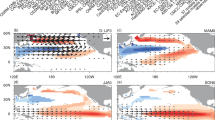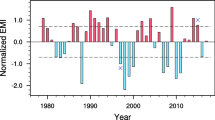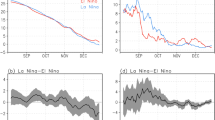Abstract
Compared to the zonal-mean Hadley cell (HC), our knowledge of the characteristics, influence factors and associated climate anomalies of the regional HC remains quite limited. Here, we examine interannual variability of the northern poleward HC edge over western Pacific (WPHCE) during boreal winter. Results suggest that interannual variability of the WPHCE is impacted by the El Niño-Southern Oscillation (ENSO) Modoki, North Pacific Oscillation (NPO) and North Atlantic Oscillation (NAO). The WPHCE tends to shift poleward during negative phase of the ENSO Modoki, and positive phases of the NPO and NAO, which highlights not merely the tropical forcing but also the extratropical signals that modulate the WPHCE. ENSO modoki, NPO and NAO modulate the WPHCE via inducing atmospheric anomalies over the western North Pacific. We further investigate the climatic impacts of the WPHCE on East Asia. The poleward shift of the northern descending branch of the WPHC results in anomalous upward (downward) motions and upper-level divergence (convergence) anomalies over south-central China (northern East-Asia), leading to increased (decreased) rainfall there. Moreover, pronounced cold surface air temperature anomalies appear over south-central China when the sinking branch of the WPHC moves poleward. Based on the temperature diagnostic analysis, negative surface temperature tendency anomalies over central China are mostly attributable to the cold zonal temperature advection and ascent-induced adiabatic cooling, while the negative anomalies over South China are largely due to the cold meridional temperature advection. These findings could improve our knowledge of the WPHCE variability and enrich the knowledge of forcing factors for East Asian winter climate.
















Similar content being viewed by others
References
Ashok K, Behera SK, Rao SA et al (2007) El Niño Modoki and its possible teleconnection. J Geophys Res 112:C11. https://doi.org/10.1029/2006JC003798
Bjerknes J (1966) A possible response of the atmospheric Hadley circulation to equatorial anomalies of ocean temperature. Tellus 18(4):820–829. https://doi.org/10.3402/tellusa.v18i4.9712
Chen SF, Wu R (2018) Impacts of winter NPO on subsequent winter ENSO: sensitivity to the definition of NPO index. Clim Dyn 50:375–389
Chen W, Graf HF, Huang RH (2000) The interannual variability of East Asian winter monsoon and its relation to the summer monsoon. Adv Atmos Sci 17(1):48–60. https://doi.org/10.1007/s00376-000-0042-5
Chen SF, Wei K, Chen W et al (2014) Regional changes in the annual mean Hadley circulation in recent decades. J Geophys Res Atmos 119(13):7815–7832. https://doi.org/10.1002/2014JD021540
Chen SF, Wu RG, Chen W (2020a) Strengthened connection between springtime North Atlantic Oscillation and North Atlantic tripole SST pattern since the late 1980s. J Clim 33:2007–2022. https://doi.org/10.1175/JCLI-D-19-0628.1
Chen SF, Wu R, Chen W, Yu B (2020b) Recent weakening of the linkage between the spring Arctic Oscillation and the following winter El Niño-Southern Oscillation. Clim Dyn 54(1):53–67
Chen SF, Wu R, Chen W, Hu KM, Yu B (2020c) Structure and dynamics of a springtime atmospheric wave train over the North Atlantic and Eurasia. Clim Dyn 54:5111–5126
Cui XP, Sun ZB (1999) East Asian winter monsoon index and its varation analysis. J Nanjing Inst Meteorol 22:321–325 ((in Chinese))
Davis SM, Rosenlof KH (2012) A multidiagnostic intercomparison of tropical-width time series using reanalyses and satellite observations. J Clim 25(4):1061–1078. https://doi.org/10.1175/JCLI-D-11-00127.1
Dee DP, Uppala SM, Simmons AJ et al (2011) The ERA-Interim reanalysis: configuration and performance of the data assimilation systems. Q J R Meteorol Soc 137:553–597. https://doi.org/10.1002/qj.828
Diaz HF, Bradley RS (2004) The Hadley circulation: present, past, and future: an introduction. In: Diaz HF, Bradley RS (eds) The Hadley circulation: present, past, and future. Kluwer Academic, New York, pp 1–5. https://doi.org/10.1007/978-1-4020-2944-8_1
Ebita A, Kobayashi S, Ota Y et al (2011) The Japanese 55-year Reanalysis “JRA-55”: an interim report. Sci Online Lett Atmos Sola 7:149–152. https://doi.org/10.2151/sola.2011-038
Feng J, Li JP (2011) Influence of El Niño Modoki on spring rainfall over South China. J Geophys Res Atmos 116(D13):D13102. https://doi.org/10.1029/2010JD015160
Feng J, Li JP (2013) Contrasting impacts of two types of ENSO on the boreal spring Hadley circulation. J Clim 26(13):4773–4789. https://doi.org/10.1175/JCLI-D-12-00298.1
Feng J, Li J, Jin FF et al (2016) Contrasting responses of the Hadley circulation to equatorially asymmetric and symmetric meridional sea surface temperature structures. J Clim 29(24):8949–8963. https://doi.org/10.1175/JCLI-D-16-0171.1
Feng J, Li JP, Jin FF et al (2018a) A comparison of the response of the Hadley circulation to different tropical SST meridional structures during the equinox seasons. J Geophys Res Atmos 123(5):2591–2604. https://doi.org/10.1002/2017JD028219
Feng J, Li JP, Kucharski F et al (2018b) Modulation of the meridional structures of the Indo-Pacific warm pool on the response of the Hadley circulation to tropical SST. J Clim 31(21):8971–8984. https://doi.org/10.1175/JCLI-D-18-0305.1
Feng J, Li JP, Jin FF et al (2019) Effect of El Nino on the response ratio of Hadley circulation to different SST meridional structures. Clim Dyn 53:3877–3891
Freitas ACV, Ambrizzi T (2015) Recent changes in the annual mean regional Hadley circulation and their impacts on South America. Adv Meteorol 2015:1–22. https://doi.org/10.1155/2015/780205
Freitas ACV, Aímola L, Ambrizzi T et al (2017) Changes in intensity of the regional Hadley cell in Indian Ocean and its impacts on surrounding regions. Meteor Atmos Phys 129(3):229–246. https://doi.org/10.1007/s00703-016-0477-6
Furtado JC, Di Lorenzo E, Anderson BT et al (2012) Linkages between the North Pacific Oscillation and central tropical Pacific SSTs at low frequencies. Clim Dyn 39(12):2833–2846. https://doi.org/10.1007/s00382-011-1245-4
Grise KM, Davis SM, Staten PW et al (2018) Regional and seasonal characteristics of the recent expansion of the tropics. J Clim 31:6839–6856. https://doi.org/10.1175/JCLI-D-18-0060.1
Grise KM, Davis SM, Simpson IR et al (2019) Recent tropical expansion: natural variability or forced response? J Clim 32(5):1551–1571. https://doi.org/10.1175/JCLI-D-18-0444.1
Guo QY (1994) Relationship between the variations of East Asian winter monsoon and temperature anomalies in China. Q J Appl Meteorol 5(2):218–225 ((in Chinese))
Guo YP, Li JP (2016) Impact of ENSO events on the interannual variability of Hadley circulation extents in boreal winter. Adv Clim Change Res 7:46–53. https://doi.org/10.1016/j.accre.2016.05.001
Guo YP, Tan ZM (2018a) Impacts of the boreal spring Indo-Pacific warm pool Hadley circulation on tropical cyclone activity over the western North Pacific. J Clim 31:1361–1375. https://doi.org/10.1175/JCLI-D-17-0422.1
Guo YP, Tan ZM (2018b) Relationship between El Niño-Southern Oscillation and the symmetry of the Hadley circulation: role of the sea surface temperature annual cycle. J Clim 31(13):5319–5332. https://doi.org/10.1175/JCLI-D-17-0788.1
Guo YP, Tan ZM (2018c) On the sensitivity of the relationship between Hadley circulation asymmetry and ENSO in CMIP5 models. Geophys Res Lett 45(17):9253–9259. https://doi.org/10.1029/2018GL079515
Held IM, Hou AY (1980) Nonlinear axially symmetric circulations in a nearly inviscid atmosphere. J Atmos Sci 37(3):515–533. https://doi.org/10.1175/1520-0469(1980)037%3c0515:NASCIA%3e2.0.CO;2
Hou AY (1998) Hadley circulation as a modulator of the extratropical climate. J Atmos Sci 55(14):2437–2457. https://doi.org/10.1175/1520-0469(1998)055%3c2437:HCAAMO%3e2.0.CO;2
Hu Y, Fu Q (2007) Observed poleward expansion of the Hadley circulation since 1979. Atmos Chem Phys 7(19):5229–5236. https://doi.org/10.5194/acp-7-5229-2007
Hu YY, Zhou C, Liu JP (2011) Observational evidence for poleward expansion of the Hadley circulation. Adv Atmos Sci 28(1):33–44. https://doi.org/10.1007/s00376-010-0032-1
Hu YY, Huang H, Zhou C (2018) Widening and weakening of the Hadley circulation under global warming. Science Bulletin 63(10):640–644. https://doi.org/10.1016/j.scib.2018.04.020
Hu DZ, Guo YP, Tan ZM et al (2019) Interannual relationship between the boreal spring Arctic oscillation and the northern hemisphere Hadley circulation extent. J Clim 32:4395–4408. https://doi.org/10.1175/JCLI-D-18-0657.1
Huang B, Thorne PW, Banzon VF et al (2017) Extended reconstructed sea surface temperature, version 5 (ERSSTv5): upgrades, validations, and intercomparisons. J Clim 30(20):8179–8205. https://doi.org/10.1175/JCLI-D-16-0836.1
Huang RP, Chen SF, Chen W et al (2018a) Interannual variability of regional Hadley circulation intensity over western Pacific during boreal winter and its climatic impact over Asia-Australia region. J Geophys Res Atmos 123:344–366. https://doi.org/10.1002/2017JD027919
Huang RP, Chen SF, Chen W et al (2018b) Has the regional Hadley circulation over western Pacific during boreal winter been strengthening in recent decades? Atmos Oceanic Sci Lett 11:454–463. https://doi.org/10.1080/16742834.2018.1507412
Huang RP, Chen SF, Chen W et al (2019) Recent strengthening of the regional Hadley circulation over the western Pacific during boreal spring. Adv Atmos Sci 36(11):1251–1264. https://doi.org/10.1007/s00376-019-9004-2
Jhun JG, Lee EJ (2004) A new East Asian winter monsoon index and associated characteristics of the winter monsoon. J Clim 17:711–726
Ji LR, Sun SQ, Arpe K et al (1997) Model study on the interannual variability of Asian winter monsoon and its influence. Adv Atmos Sci 14(1):1–22. https://doi.org/10.1007/s00376-997-0039-4
Kalnay E, Kanamitsu M, Kistler R et al (1996) The NCEP/NCAR 40-year reanalysis project. Bull Am Meteor Soc 77(3):437–472. https://doi.org/10.1175/1520-0477(1996)077%3c0437:TNYRP%3e2.0.CO;2
Kanamitsu M, Ebisuzaki W, Woollen J et al (2002) NCEP-DOE AMIP-II reanalysis (R-2). Bull Am Meteor Soc 83:1631–1643. https://doi.org/10.1175/BAMS-83-11-1631
Kossin JP, Emanuel KA, Vecchi GA (2014) The poleward migration of the location of tropical cyclone maximum intensity. Nature 509:349–352. https://doi.org/10.1038/nature13278
Kossin JP, Emanuel KA, Camargo SJ (2016) Past and projected changes in western North Pacific tropical cyclone exposure. J Clim 29:5725–5739. https://doi.org/10.1175/JCLI-D-16-0076.1
Li JP, Ruan CQ (2018) The North Atlantic-Eurasian teleconnection in summer and its effects on Eurasian climates. Environ Res Lett. https://doi.org/10.1088/1748-9326/aa9d33
Li YQ, Yang S (2010) A dynamical index for the East Asian winter monsoon. J Clim 23(15):4255–4262. https://doi.org/10.1175/2010JCLI3375.1
Li JP, Zheng F, Sun C et al (2019) Pathways of influence of the Northern Hemisphere mid-high latitudes on East Asian climate: a review. Adv Atmos Sci 36:902–921. https://doi.org/10.1007/s00376-019-8236-5
Lindzen RS, Hou A (1988) Hadley circulations for zonally averaged heating centered off the equator. J Atmos Sci 45(17):2416–2427. https://doi.org/10.1175/1520-0469(1988)045%3c2416:HCFZAH%3e2.0.CO;2
Lu J, Vecchi GA, Reichler T (2007) Correction to “Expansion of the Hadley cell under global warming.” Geophys Res Lett 34(14):L14808. https://doi.org/10.1029/2007GL030931
Lucas C, Nguyen H (2015) Regional characteristics of tropical expansion and the role of climate variability. J Geophys Res Atmos 120(14):6809–6824. https://doi.org/10.1002/2015JD023130
Lucas C, Timbal B, Nguyen H (2014) The expanding tropics: a critical assessment of the observational and modeling studies. Wiley Interdiscipl Rev Clim Change 5(1):89–112. https://doi.org/10.1002/wcc.251
Ma J, Li JP (2008) The principal modes of variability of the boreal winter Hadley cell. Geophys Res Lett 35:L01808. https://doi.org/10.1029/2007GL031883
Mitas CM, Clement A (2005) Has the Hadley cell been strengthening in recent decades? Geophys Res Lett 32(3):L03809. https://doi.org/10.1029/2004GL021765
Mitas CM, Clement A (2006) Recent behavior of the Hadley cell and tropical thermodynamics in climate models and reanalyses. Geophys Res Lett 33(1):L01810. https://doi.org/10.1029/2005GL024406
Nguyen H, Evans A, Lucas C et al (2013) The Hadley circulation in reanalyses: climatology, variability, and change. J Clim 26(10):3357–3376. https://doi.org/10.1175/JCLI-D-12-00224.1
Nguyen H, Lucas C, Evans A et al (2015) Expansion of the Southern Hemisphere Hadley cell in response to greenhouse gas forcing. J Clim 28(20):8067–8077. https://doi.org/10.1175/JCLI-D-15-0139.1
Nguyen H, Hendon HH, Lim EP et al (2018) Variability of the extent of the Hadley circulation in the southern hemisphere: a regional perspective. Clim Dyn 50:129–142. https://doi.org/10.1007/s00382-017-3592-2
Oort AH, Rasmusson EM (1970) On the annual variation of the monthly mean meridional circulation. Mon Wea Rev 98(6):423–442. https://doi.org/10.1175/1520-0493(1970)098%3c0423:OTAVOT%3e2.3.CO;2
Oort AH, Yienger JJ (1996) Observed interannual variability in the Hadley circulation and its connection to ENSO. J Clim 9(11):2751–2767. https://doi.org/10.1175/1520-0442(1996)009%3c2751:OIVITH%3e2.0.CO;2
Park JY, Yeh SW, Kug JS et al (2013) Favorable connections between seasonal footprinting mechanism and El Niño. Clim Dyn 40:1169–1181. https://doi.org/10.1007/s00382-012-1477-y
Rayner NA, Parker DE, Horton EB et al (2003) Global analyses of sea surface temperature, sea ice, and night marine air temperature since the late nineteenth century. J Geophys Res Atmos 108(D14):4407. https://doi.org/10.1029/2002JD002670
Ruan CQ, Li JP, Feng J (2015) Statistical downscaling model for late-winter rainfall over Southwest China. Sci China Earth Sci 58:1827–1839. https://doi.org/10.1007/s11430-015-5104-8
Scheff J, Frierson D (2012) Twenty-first-century multimodel subtropical precipitation declines are mostly midlatitude shifts. J Clim 25(12):4330–4347. https://doi.org/10.1175/JCLI-D-11-00393.1
Schmidt DF, Grise KM (2017) The response of local precipitation and sea level pressure to Hadley cell expansion. Geophys Res Lett 44:10573–10582. https://doi.org/10.1002/2017GL075380
Schwendike J, Govekar P, Reeder MJ et al (2014) Local partitioning of the overturning circulation in the tropics and the connection to the Hadley and Walker circulations. J Geophys Res Atmos 119(3):1322–1339. https://doi.org/10.1002/2013JD020742
Seidel DJ, Fu Q, Randel WJ et al (2008) Widening of the tropical belt in a changing climate. Nat Geosci 1(1):21–24. https://doi.org/10.1038/ngeo.2007.38
Sharmila S, Walsh KJE (2018) Recent poleward shift of tropical cyclone formation linked to Hadley cell expansion. Nature Clim Change 8(8):730–736. https://doi.org/10.1038/s41558-018-0227-5
Shi N (1996) Features of the East Asian winter monsoon intensity on multiple time scale in recent 40 years and their relation to climate. Q J Appl Meteorol 7(2):175–182 ((in Chinese))
Stachnik JP, Schumacher C (2011) A comparison of the Hadley circulation in modern reanalyses. J Geophys Res Atmos 116(D22):D22102. https://doi.org/10.1029/2011JD016677
Staten PW, Lu J, Grise KM et al (2018) Re-examining tropical expansion. Nat Clim Change 8(9):768–775. https://doi.org/10.1038/s41558-018-0246-2
Staten PW, Grise KM, Davis SM et al (2019) Regional widening of tropical overturning: forced change, natural variability, and recent trends. J Geophys Res Atmos. https://doi.org/10.1029/2018JD030100
Studholme J, Gulev S (2018) Concurrent changes to Hadley circulation and the meridional distribution of tropical cyclones. J Clim 31:4367–4389. https://doi.org/10.1175/JCLI-D-17-0852.1
Sun BM, Li CY (1997) Relationship between the disturbances of East Asian trough and tropical convective activities in boreal winter. Chin Sci Bull 42(5):500–504 ((in Chinese))
Takaya K, Nakamura H (1997) A formulation of a wave-activity flux for stationary Rossby waves on a zonally varying basic flow. Geophys Res Lett 24:2985–2988. https://doi.org/10.1029/97GL03094
Takaya K, Nakamura H (2001) A formulation of a phase-independent wave-activity flux for stationary and migratory quasigeostrophic eddies on a zonally varying basic flow. J Atmos Sci 58:608–627. https://doi.org/10.1175/1520-0469(2001)058,0608:AFOAPI.2.0.CO;2
Totz S, Petri S, Lehmann J et al (2018) Regional changes in the mean position and variability of the tropical edge. Geophys Res Lett 45(21):12076–12084. https://doi.org/10.1029/2018GL079911
Wang CZ (2002) Atmospheric circulation cells associated with the El Niño-southern oscillation. J Clim 15(4):399–419. https://doi.org/10.1175/1520-0442(2002)015%3c0399:ACCAWT%3e2.0.CO;2
Wang L, Chen W (2010) How well do existing indices measure the strength of the East Asian winter monsoon? Adv Atmos Sci 27(4):855–870. https://doi.org/10.1007/s00376-009-9094-3
Wang YQ, Feng J, Li JP et al (2020) Variability of boreal spring Hadley circulation over the Asian monsoon domain and its relationship with tropical SST. Clim Dyn 54:1655–1669. https://doi.org/10.1007/s00382-019-05079-3
Willmott CJ, Matsuura K (2001) Terrestrial air temperature and precipitation: monthly and annual time series (1950–1999). http://climate.geog.udel.edu/~climate/html_pages/README.ghcn_ts2.html
Yang S, Lau KM, Kim KM (2002) Variations of the East Asian jet stream and Asian-Paciflc-American winter climate anomalies. J Clim 15:306–325
Zeng G, Wang WC, Sun ZB et al (2011) Atmospheric circulation cells associated with anomalous East Asian winter monsoon. Adv Atmos Sci 28(4):913–926. https://doi.org/10.1007/s00376-010-0100-6
Zhang G, Wang Z (2013) Interannual variability of the Atlantic Hadley circulation in boreal summer and its impacts on tropical cyclone activity. J Clim 26(21):8529–8544. https://doi.org/10.1175/JCLI-D-12-00802.1
Zhang G, Wang Z (2015) Interannual variability of tropical cyclone activity and regional Hadley circulation over the Northeastern Pacific. Geophys Res Lett 42(7):2473–2481. https://doi.org/10.1002/2015GL063318
Zhao HX, Moore GWK (2008) Trends in the boreal summer regional Hadley and Walker circulations as expressed in precipitation records from Asia and Africa during the latter half of the 20th century. Int J Climatol 28(5):563–578. https://doi.org/10.1002/joc.1580
Zhao YF, Zhu J (2015) Assessing quality of grid daily precipitation datasets in China in recent 50 years. Plateau Meteorol 34:50–58. https://doi.org/10.7522/j.issn.1000-0534
Zhao YF, Zhu J, Xv Y (2014) Establishment grid precipitation datasets in china for recent 50 years. J Meteorol Sci 34:414–420. https://doi.org/10.3969/2013jms.0008
Zhao W, Chen SF, Chen W, Yao S, Nath D, Yu B (2019) Interannual variations of the rainy season withdrawal of the monsoon transitional zone in China. Clim Dyn 53:2031–2046
Zuo JQ, Ren HL, Li WJ et al (2016) Interdecadal variations in the relationship between the winter North Atlantic Oscillation and temperature in South-Central China. J Clim 29(20):7477–7493. https://doi.org/10.1175/JCLI-D-15-0873.1
Acknowledgements
We thank the three anonymous reviewers for their constructive suggestions and comments, which help to improve the paper. This study is supported jointly by the National Key Research and Development Program (Grant no. 2018YFC1507602), the National Natural Science Foundation of China (Grant nos. 41230527, 41605050, 41661144016). The NCEP1 and NCEP 2 data were obtained from ftp://ftp.cdc.noaa.gov/. The ERAINT data were obtained from http://apps.ecmwf.int/. The JRA55 data were obtained from http://jra.kishou.go.jp/JRA-55/index_en.html. The DEL rainfall and SAT data and ERSST.v5 data were obtained from https://www.esrl.noaa.gov/psd/data/gridded/index.html. The HadISST data were obtained from http://www.metoffice.gov.uk/hadobs/hadisst/.
Author information
Authors and Affiliations
Corresponding author
Additional information
Publisher's Note
Springer Nature remains neutral with regard to jurisdictional claims in published maps and institutional affiliations.
Rights and permissions
About this article
Cite this article
Huang, R., Chen, S., Chen, W. et al. Northern poleward edge of regional Hadley cell over western Pacific during boreal winter: year-to-year variability, influence factors and associated winter climate anomalies. Clim Dyn 56, 3643–3664 (2021). https://doi.org/10.1007/s00382-021-05660-9
Received:
Accepted:
Published:
Issue Date:
DOI: https://doi.org/10.1007/s00382-021-05660-9




